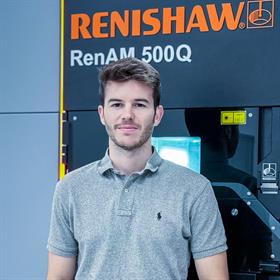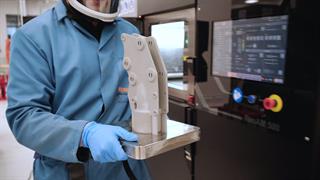Employee perspectives - Alex Garcia
I'm an engineer proud to work in additive manufacturing.

Additive manufacturing (AM) is transforming the world of engineering, with applications across industries including automotive, aerospace and healthcare. Engineers can now create optimised components for jet engines or racing yachts to enhance their performance and design.
Here, Alex Garcia, an Additive Manufacturing Design and Applications Engineer at Renishaw, discusses his journey from a graduate to an Additive Manufacturing Engineer, his daily challenges and the excitement surrounding recent advancements in the industry.
From an early age, I saw myself as an engineer, driven by my childhood passion for aircraft. Originally from Pamplona in Spain, I moved to Madrid to study aerospace engineering at Alfonso X El Sabio University. In my final year, I received a scholarship to complete my degree at the University of Tennessee, specialising in aircraft design. As a fresh graduate, I reached out to Renishaw for a chance to gain experience in the sector and was offered a full-time position as an Additive Manufacturing Engineer at Renishaw's AM facility in Barcelona.
Life in additive manufacturing
The life of an Additive Manufacturing Engineer is never dull, with projects ranging from titanium watch straps to aircraft assembly improvements and advanced orthopaedic implants. Each day presents new challenges and opportunities. A significant aspect of the process involves using specialised software to input the desired parameters and generate designs. However, this technology is still evolving and is often not designed for the unique properties of AM. As a result, many components require complete reworking. To address these issues, Renishaw provides training for its customers on the fundamentals of AM. This empowers them to maximise the potential of the technology in their designs, ensuring more efficient and effective outcomes.
Renishaw make strides in the industry
I have been on a seven-year journey, partnering with ITP Aero in the production of TP400 rear engine vanes. I have been responsible for the parameter development of these high-quality components using Renishaw's AM technology. The seven-year project has come to its end and marks the first additive component in the industry to receive Design Organisation Approval from the EASA (European Union Aviation Safety Agency).

Renishaw also collaborated with INEOS Britannia to optimise the design and manufacture of parts for the team's prototype and final boats for the America's Cup. Effective engineering was crucial to designing all these components for AM production on Renishaw's RenAM 500Q system, allowing us to achieve the complex geometries required without adding any residual stress during printing or adding weight that reduces performance.
The future of additive manufacturing
The future of AM looks promising, we're seeing the rapid evolution of software that maximises the technology's benefits. Renishaw is utilising our own detailed system knowledge and working with third-party software companies to get these advances into our customers' hands as quickly as possible. Renishaw envisions AM becoming an integral component of multiple industries in the future. I am proud to be part of this exciting journey.
Biography
- Studied Aerospace engineering at Alfonso X El Sabio University, Madrid, Spain 2012-2015
- Finalised his Aerospace Engineering degree at the University of Tennessee, Knoxville, USA 2015-2016
- Joined Renishaw as an Additive Manufacturing Design Engineer in 2017